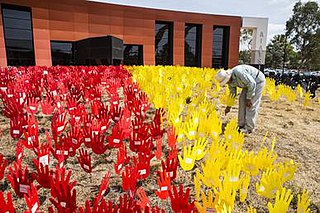Related Research Articles

The Australian Institute of Aboriginal and Torres Strait Islander Studies (AIATSIS), established as the Australian Institute of Aboriginal Studies (AIAS) in 1964, is an independent Australian Government statutory authority. It is a collecting, publishing, and research institute and is considered to be Australia's premier resource for information about the cultures and societies of Aboriginal and Torres Strait Islander peoples.

Norman Barnett Tindale AO was an Australian anthropologist, archaeologist, entomologist and ethnologist. He is best remembered for his work mapping the various tribal groupings of Aboriginal Australians at the time of European settlement, shown in his map published in 1940. This map provided the basis of a map published by David Horton in 1996 and widely used in its online form today. Tindale's major work was Aboriginal Tribes of Australia: Their terrain, Environmental Controls, Distribution, Limits and Proper Names (1974).
The Yawuru, also spelt Jawuru, are an Aboriginal Australian people of the Kimberley region of Western Australia.

The Dadi Dadi or Tatitati are an Australian Aboriginal people whose traditional lands are located along the southern banks of the Murray River in Victoria Australia.
The Miriwoong people, also written Miriwung and Miriuwung, are an Aboriginal Australian people of the Kimberley region of northern Western Australia.

The Wadandi, also spelt Wardandi and other variants, are an Aboriginal people of south-western Western Australia, one of fourteen language groups of the Noongar peoples.
The Bibulman (Pibelmen) are an Aboriginal Australian people of the southwestern region of Western Australia, a subgroup of the Noongar.
The Mutumui were an indigenous Australian people of northern Queensland.
The Dingaal people, also known as Walmbarddha or Walmbaria, are an Aboriginal Australian people of Cape York Peninsula in northern Queensland.
The Jadira are a people and territory in the Pilbara region of Western Australia.
The Thalanyji, also spelt Thalandji, Dhalandji, and other variations, are an Aboriginal Australian people in the Pilbara region of Western Australia.
The Ninanu were an Aboriginal Australian people of the Gascoyne region of Western Australia.
The Wariangga, also written Warriyangka, are an Aboriginal Australian people of the Gascoyne region in Western Australia.
The Ngaatjatjarra are an Indigenous Australian people of Western Australia, with communities located in the north eastern part of the Goldfields-Esperance region.
The Ngombal, also known as the Ngumbarl, are an Aboriginal Australian people of Western Australia.
The Madoitja or Tjupany were an Aboriginal Australian people of Western Australia.
The Malngin are an Aboriginal Australian people of the Kimberley region of Western Australia. The Malngin language was a dialect of Gurindj.
The Kokatha, also known as the Kokatha Mula, are an Aboriginal Australian people of the state of South Australia. They speak the Kokatha language, close to or a dialect of the Western Desert language.
The Yankunytjatjara people, also written Yankuntjatjarra, Jangkundjara, and other variants, are an Aboriginal Australian people of the state of South Australia.
The Kukatj are an Aboriginal Australian people of the Cape York Peninsula in the state of Queensland. They are to be distinguished from the Kukatja of Western Australia and the Luritja of the Northern Territory, who have also historically been known as Kukatja.
References
- "AIATSIS map of Indigenous Australia". AIATSIS. 14 May 2024.
- "Tindale Tribal Boundaries" (PDF). Department of Aboriginal Affairs, Western Australia. September 2016. Archived from the original (PDF) on 8 March 2016. Retrieved 1 December 2017.
- Burke, Paul (2011). Law's Anthropology:From ethnography to expert testimony in native title (PDF). Australian National University Press. ISBN 978-1-921-86243-4.
- Tindale, Norman Barnett (1974). "Djugun (WA)". Aboriginal Tribes of Australia: Their Terrain, Environmental Controls, Distribution, Limits, and Proper Names. Australian National University Press. ISBN 978-0-708-10741-6. Archived from the original on 20 March 2020.